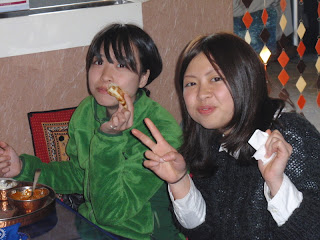One complication to people's ages is that until this century, people in Japan were considered to be one year old at birth.
Shichi Go San, or the “Seven-Five-Three” Festival, is observed on November 15th of every year. On this day, five-year-old boys, along with three- and seven-year-old girls, are dressed in kimonos and blessed by a Shinto priest for their continued health and well-being. It was originally believed that children of these particular ages were especially prone to bad luck. The Shinto blessing and prayers were thus thought to provide divine protection for children at the critical points in their formative years. The observance has come to be regarded as a momentous rite of passage, as it represents the child’s elevation to “little men” and “little women.”
In an earlier post I wrote about the Coming of Age celebration for 20 year olds.
For men, the 60th birthday is called kanreki, the recognition of his “second infancy.” The Japanese characters in the word kanreki literally mean “return” and “calendar.” The traditional calendar, which was based on the Chinese calendar, was organized on 60-year cycles. The cycle of life returns to its starting point in 60 years, and as such, kanreki celebrates that point in a man’s life when his personal calendar has returned to the calendar sign under which he was born. Traditionally, friends and relatives are invited for a celebratory feast on one’s 60th birthday. It is customary for the celebrant to be given a red hood and wear a red vest. These clothes are usually worn by babies and thus symbolize the celebrant’s return to his birth.
Ga no iwai (also known as toshiiwai) is a Japanese rite of passage celebrated at various ages to pray for long life. This tradition was brought to Japan from China, and originally was celebrated once every ten years beginning when one turned 40 according to the traditional Japanese method of calculating age. Since the sixteenth century, ga no iwai has come to be celebrated beginning when one turns 60 (kanreki), and subsequently at ages 70 (koki), 77 (kiju), 80 (sanju), 88 (beiju), 90 (sotsuju), and 99 (hakuju).
Ga no iwai (also known as toshiiwai) is a Japanese rite of passage celebrated at various ages to pray for long life. This tradition was brought to Japan from China, and originally was celebrated once every ten years beginning when one turned 40 according to the traditional Japanese method of calculating age. Since the sixteenth century, ga no iwai has come to be celebrated beginning when one turns 60 (kanreki), and subsequently at ages 70 (koki), 77 (kiju), 80 (sanju), 88 (beiju), 90 (sotsuju), and 99 (hakuju).
Bad luck ages are referred to as yakudoshi, with yakudoshi party. Yaku means calamity and doshi means years. These years are considered dangerous because they are believed to bring bad luck or disaster.
For men the ages of 25 and 41 are deemed critical years, with 41 being especially critical. It is customary in these unlucky years to visit temples and shrines to provide divine protection from harm.
The equivalent yakudoshi ages for women are 18 and 32, with 32 thought to be a particularly hard, terrible or disastrous year.
I'll have to try to remember what happened when I was 18 and 32 to see if they were Yakudoshi years for me!
Today is another of the Winter Activities – Box Sleigh Race. Here’s a photo of the course preparation – more on this activity tomorrow!



No comments:
Post a Comment